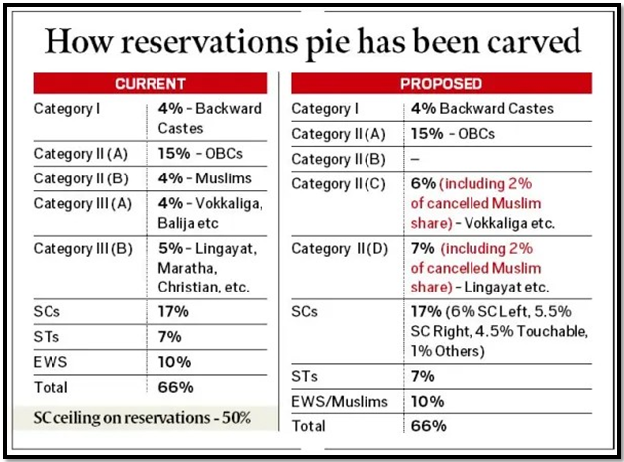THE ISSUE WITH SUB-CASTE RESERVATIONS
Syllabus:
GS 2 :
- Government Policies and Interventions for Development in various sectors and Issues arising out of their Design and Implementation.
- Welfare Schemes for Vulnerable Sections of the population by the Centre and States.
Why in the News?
The Supreme Court’s pending decision on sub-caste reservations for SC/STs has sparked a significant debate. The issue has raised questions about the legal and academic justifications for such reservations, highlighting the need to address historical and present-day inequalities within the broader framework of existing policies
Source: IE
Legal and Academic Basis
- SC Decision Reserved: The Supreme Court’s decision on sub-caste reservation for SC/STs is pending, requiring justification on legal and academic grounds.
- Weak Academic Basis: The academic rationale for sub-caste reservation is considered weak, highlighting the need for a robust foundation for such policies.
- Three Policy Instruments: The government has used legal safeguards, reservations in public sectors, and measures to improve ownership of capital assets for SC/STs.
- Ambedkar’s Vision: B.R. Ambedkar justified these measures based on the overall denial of rights and isolation faced by untouchables, not specific sub-castes.
- Complementary Measures: Ambedkar’s policies were meant to complement each other, ensuring a holistic approach to addressing discrimination and empowerment.
- Clarification Needed: Understanding the interconnection between legal safeguards, reservations, and economic empowerment is crucial for addressing sub-caste reservation issues.
Ambedkar’s Proposals
- Legal Safeguards: Ambedkar proposed legal measures against caste discrimination, essential for ensuring fair treatment in the present.
- Supplementary Reservation: Legal measures alone were insufficient; reservations in legislature, jobs, and education were necessary to supplement legal safeguards.
- Addressing the Present: Legal safeguards and reservations together aim to address present discrimination but have limitations in rectifying historical injustices.
- Economic Empowerment: A third policy focused on improving ownership of capital assets was essential to enhance the capabilities of untouchable youth.
- Holistic Focus: Reservations targeted the social group as a whole, while economic policies focused on individuals lacking income-earning assets and education.
- Policy Integration: Effective integration of these policies is necessary to ensure comprehensive empowerment and fair representation for SC/ST communities.
Sub-Caste Reservation Debate
- Supporters’ Argument: Proponents argue that some sub-castes benefit more, advocating for separate quotas for lagging sub-castes.
- Low Education Impact: Lower shares in public jobs for some sub-castes may stem from low education levels, not discrimination by other sub-castes.
- Focus on Capital Assets: Enhancing ownership of capital assets and education is crucial for improving job and education participation for lagging sub-castes.
- Policy Alternatives: Economic and educational empowerment, as suggested by Ambedkar, is a more effective alternative than sub-caste reservations alone.
- Individual Focus: Policies should target SC individuals lacking capital assets and education, enabling better utilization of job and education reservations.
- Potential Consequences: Sub-caste reservations without addressing underlying issues may perpetuate low participation and create a mirror image of caste society.
Legal and Social Realities
- Economic and Social Factors: Legal solutions for discriminated groups must consider economic and social realities impacting under-representation in jobs.
- Assessing Discrimination: Legal authorities need to determine whether under-representation is due to caste discrimination or lack of income and education.
- Unlikely Discrimination: Discrimination by other sub-castes as a reason for under-representation is unlikely; lack of capabilities due to low income and education is more probable.
- Individual Focus Policy: An individual-focused policy targeting economic and educational empowerment is a better alternative for effective use of reservations.
- Floodgate Concerns: Unjustified sub-caste reservations may open the floodgates for demands from numerous sub-castes, complicating the reservation policy.
- Mirror Image: The reservation policy could become a reflection of caste society, perpetuating divisions and undermining the original intent of reservations.
| About Sub-Categorisation Within Castes
About
Legality of Sub-Categorisation
|
Way Forward for Effective Policy Implementation :
- Enhancing Capabilities: Improving ownership of capital assets and education levels for lagging sub-castes is essential for better access to jobs and education.
- Holistic Approach: A comprehensive approach integrating legal safeguards, reservations, and economic empowerment is necessary for effective representation and empowerment.
- Data-Driven Decisions: Legal authorities must base decisions on accurate data and academic justification to address the issues effectively.
- Avoiding Missteps: Implementing sub-caste reservations without addressing fundamental issues may leave problems unaddressed and perpetuate existing disparities.
- Balanced Policy: A balanced policy focusing on individual needs and overall group empowerment is crucial for achieving equitable representation and opportunities.
- Long-Term Vision: A long-term vision integrating economic, educational, and legal measures is essential for sustainable empowerment and social justice for SC/ST communities.
- Stakeholder Collaboration: Collaboration between government, academia, and community leaders is vital to ensure policies are effectively designed and implemented.
- Monitoring and Evaluation: Regular monitoring and evaluation of policies and their impact are necessary to make data-driven adjustments and improvements.
- Capacity Building: Investing in capacity building for SC/ST individuals through training programs can enhance their skills and readiness for job opportunities.
Conclusion
A holistic approach integrating legal safeguards, reservations, and economic empowerment is essential for effective SC/ST representation. Sub-caste reservations must be justified with robust data and academic reasoning to avoid perpetuating existing disparities and ensure equitable opportunities for all disadvantaged groups within these communities.
Source:The Hindu
Mains Practice Question:
Discuss the challenges and implications of implementing sub-caste reservations for SC/ST communities in India. Critically analyze whether such reservations align with Dr. B.R. Ambedkar’s vision of social justice and empowerment. (250 words)
Associated Article:




